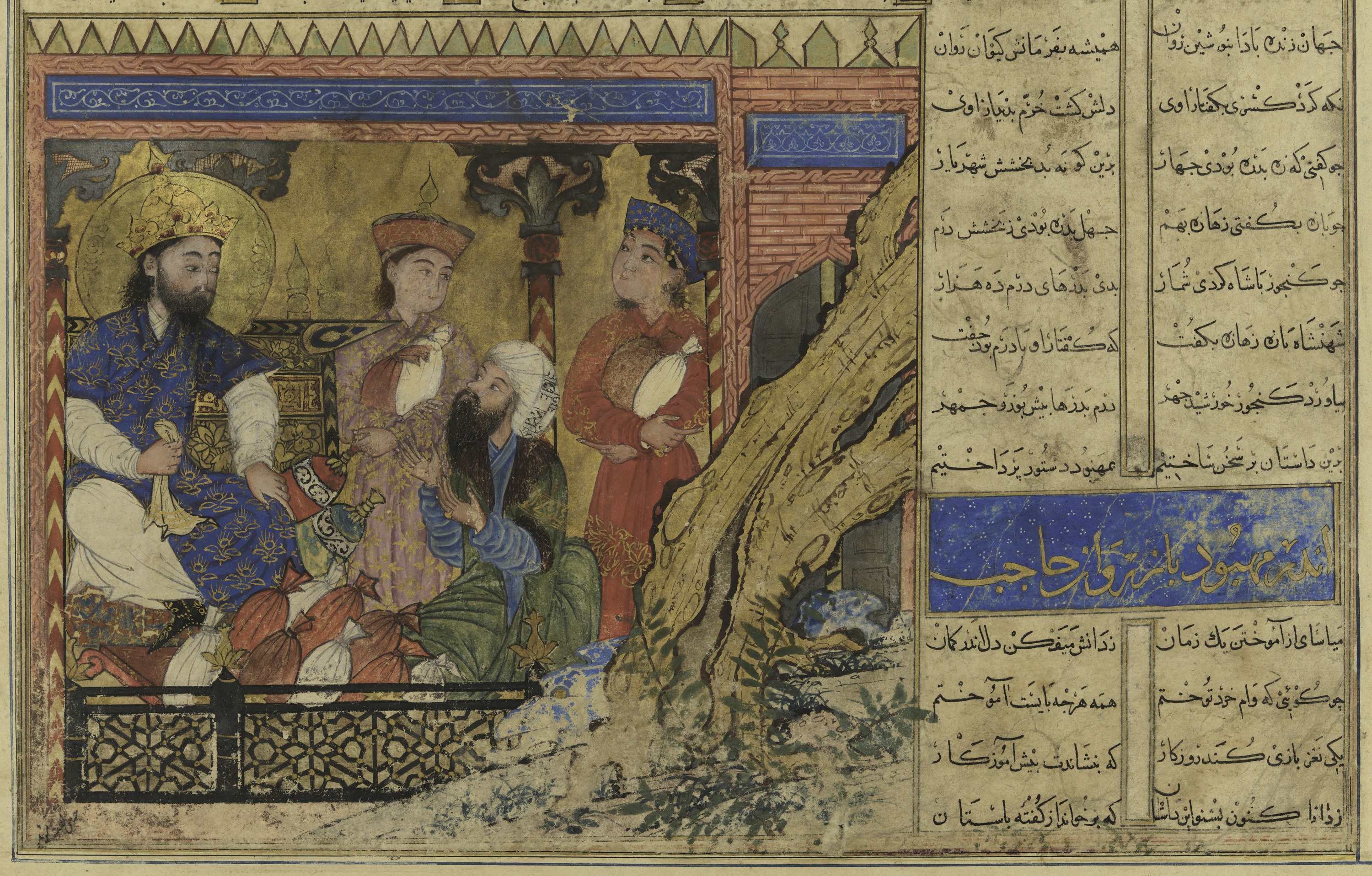National Museum of Asian Art Presents “An Epic of Kings: The Great Mongol Shahnama”

Detail of “Folio from a ‘Shahnama’ (‘Book of Kings’) by Firdawsi (d. 1020); Anushirvan bestowing largess upon his minister Buzurjmihr” / Credit: National Museum of Asian Art, Smithsonian Institution, Freer Collection, Purchase—Charles Lang Freer Endowment, F1942.2 (detail)
The Smithsonian’s National Museum of Asian Art has announced “An Epic of Kings: The Great Mongol Shahnama,” an exhibition on the first imperial copy of Iran’s national epic, Firdawsi’s “Book of Kings.” It will open at the museum Sept. 21 and remain on view until Jan. 12, 2025. The manuscript, completed sometime between 1330 and 1336 in Tabriz, the capital of the Ilkhanids, the Mongol rulers of Iran (1256–1353), is a masterpiece as much for its impressive scale (60 x 40 centimeters [about 24 x 16 inches]) as for its exceptional paintings. It exemplifies the remarkable artistic originality that flourished under Ilkhanid rule, a period traditionally associated with upheaval and destruction rather than creativity.
For the first time ever, the exhibition assembles 24 folios from the manuscript, focusing on the series of illustrated folios depicting Iran’s historical rulers—beginning with Alexander the Great. “An Epic of Kings” not only includes works from Yuan and Ming China, but also from the medieval Mediterranean world and the Latin West; this highlights the cosmopolitan nature of the Ilkhanid empire and the development of a particular and rich pictorial language as the dynasty strengthened its position at the crossroads of the East and West.
With more than 60 objects on display, “An Epic of Kings” includes works from the museum’s own holdings alongside loaned works from the Cleveland Art Museum, the Harvard Art Museums, the J. Paul Getty Museum, the Keir Collection—currently on loan to the Dallas Museum of Art—and several prominent private collections. The National Museum of Asian Art holds one of America’s preeminent collections of the arts of the Islamic world, with particular strengths in illustrated manuscripts and ceramics among the more than 2,200 objects.
“In our second century, the National Museum of Asian Art is committed to engaging in dynamic collaborations beyond our four walls and to telling compelling stories about object histories,” said Chase F. Robinson, the museum’s director. “‘An Epic of Kings’ would not be possible without the generosity of these institutions that lent us exceptional works of art including some folios from this manuscript, enabling us to offer a rare chance to view many pages from a medieval Persian masterpiece and to invite visitors to learn more about the complexities of its creation in the 14th century.”
“‘The Great Mongol Shahnama’ truly represents a watershed in the history of Persian painting,” said Simon Rettig, the National Museum of Asian Art’s associate curator for the arts of the Islamic world. “There is nothing like it before and after, and the folios on view in the exhibition show how unique and grand a manuscript it was.”
In preparation for the exhibition, the department of conservation and scientific research collaborated with the curatorial department to analyze the museum’s “Great Mongol Shahnama” paintings. A short video on pigment analysis and X-ray investigation of the works will be displayed in the exhibition to show some of the preliminary results. An extensive e-publication discussing some of the major results of this research is scheduled for release in spring 2025.
The National Museum of Asian Art’s Department of Conservation and Scientific Research repaired many delicate, ancient works for this exhibition. Part of the process is documented in a viral video that showcases a technique called a “fill,” when paper or other material is used to fill in a missing part to prevent further damage.
Event
Sneak Peek: New Research from the National Museum of Asian Art
Online Zoom discussion; details forthcoming
Tuesday, Sept. 10; noon–12:40 p.m. ET
Rettig will share an insider's view of the exhibition “An Epic of Kings: The Great Mongol Shahnama” as part of a monthly scholarly program series.
About the National Museum of Asian Art
The Smithsonian’s National Museum of Asian Art is committed to preserving, exhibiting, researching and interpreting art in ways that deepen our collective understanding of Asia, the United States and the world. Home to more than 46,000 objects, the museum stewards one of North America’s largest and most comprehensive collections of Asian art, with works dating from antiquity to the present from China, Japan, Korea, South Asia, Southeast Asia and the Islamic world. Its rich holdings bring the arts of Asia into direct dialogue with an important collection of 19th- and early 20th-century art from the United States, providing an essential platform for creative collaboration and cultural exchange between the U.S., Asia and the Middle East. The National Museum of Asian Art’s collection includes one of America’s finest collections of the arts of the Islamic world, with particular strengths in works on paper and ceramics among more than 2,200 objects.
Beginning with a 1906 gift that paved the way for the museum’s opening in 1923, the National Museum of Asian Art is a leading resource for visitors, students and scholars in the United States and internationally. Its galleries, laboratories, archives and library are located on the National Mall in Washington, D.C., and are part of the world’s largest museum complex, which typically reports more than 27 million visits each year. The museum is free and open to the public 364 days a year (closed Dec. 25), making its exhibitions, programs, learning opportunities and digital initiatives accessible to global audiences.
For more information, visit the museum’s website and follow updates on Instagram at @natasianart, X at @NatAsianArt and Facebook at @NatAsianArt.
# # #
SI-212A-2024
